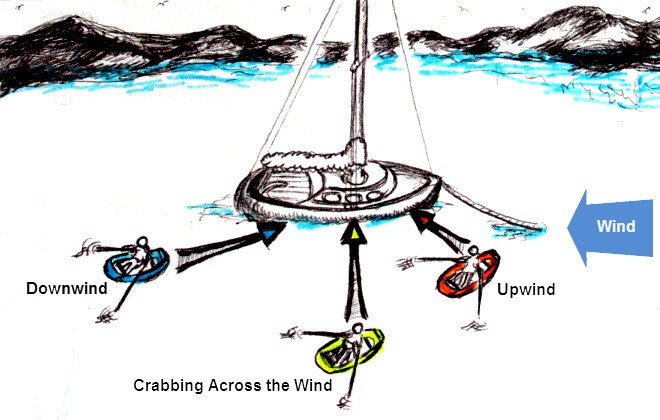Three ways to approach your sailboat by dinghy
by John Jamieson on 21 Jan 2012

Choose your boat dinghy approach with care. Will you make an approach from downwind, crab across the wind, or approach from upwind? Use your cruising boat to judge the wind direction. Captain John Jamieson
http://www.skippertips.com
How many times have you found your boat dinghy tough to control in wind or current? Do you know the three approach choices you can make for a perfect landing every time? Follow these easy steps in any marine weather.
Equip Your Dinghy with the Right Gear!
I recently visited a local marina and walked past the dinghy dock. All twelve dinghies had outboard motors, but only one had a pair of oars and just two had an anchor aboard! Many sailing skippers rely on outboard motors, but these can fail when you least expect it. Now what, skipper?
Equip your dinghy with stout oarlocks and a proper set of aluminum or wooden oars. If your engine fails, you will have auxiliary power to get you home. Add a small, light-weight Danforth or Fortress anchor on all rope rode. In an emergency, this will keep you in place until you can work things out. Carry a powerful, battery-operated lantern. Use the light at night to warn others of your position, signal for help, or help locate your anchored or moored boat.
How Should You Make Your Approach?
Choose your boat dinghy approach with care. Will you make an approach from downwind, crab across the wind, or approach from upwind? Before you begin, determine the direction of wind or current. Your small cruising boat will be lying at anchor with the bow pointed into the stronger of either wind or current. You have three approach choices for landing alongside. This list shows approaches from the most desirable to the least desirable:
* Downwind Approach
* Crabbing Across the Wind
* Upwind Approach
Remember, if you start on one approach and find it's not working, change your strategy to another approach. For fun, practice all of the approaches below so that they will become second nature once you are out cruising. Use the steps below along with the illustration:
Downwind Approach
1. Aim for a point near your boat's quarter (aft corner).
2. Keep the dinghy headed into the wind or current at a narrow angle. In a chop, meet the waves at a slight angle instead of head-on.
3. Tie off a bow line as soon as you land. Snug up the dinghy alongside with a stern line before de-boarding.
Crabbing Across the Wind
1. Aim the dinghy toward the bow of your small cruising boat.
2. Keep the dinghy angled 45 degrees into the wind or current. Look over your shoulder; concentrate on your cruising boat's beam. Use just enough power (engine or oars) to allow the dinghy to set down onto the beam of the boat.
3. Tie off a bow line as soon as you land. Snug up the dinghy alongside with a stern line before de-boarding.
Upwind Approach
1. Aim for your boat's anchor rode. This provides you with a good reference point.
2. Keep the dinghy headed into the wind or current at a narrow angle. If you find the boat setting down too fast, use more power (engine or oars).
3. Tie off a bow line to the anchor rode or the bow of your cruising boat. The dinghy will blow down alongside. Snug up the dinghy alongside with a stern line before de-boarding.
As a sailing skipper, you need to know different ways to land a boat dinghy alongside your anchored cruising boat. Use these tips to make safe, controlled dinghy approaches in any wind or current.
John Jamieson (Captain John) with 25+ years of experience shows you the no-nonsense cruising skills you need beyond sailing school. Visit his website for a free sailing tips newsletter. Become a member for instant access to 500+ articles, instructional videos, newsletters, e-Books, and live discussion forums.
If you want to link to this article then please use this URL: www.sailworldcruising.com/93112